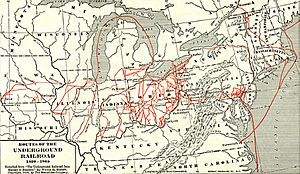Underground Railroad in Harrisburg, Pennsylvania facts for kids

Harrisburg played a super important role in the Underground Railroad, which was a secret network helping enslaved people find freedom. It was successful for a few key reasons. One big reason was the large number of free African Americans living there who could help runaways. Also, many different routes passed through the area, making it a good stopping point.
Contents
Why Harrisburg Was Important
African American people moved to Harrisburg from nearby farms and from states like Virginia and Maryland. Some were escaping slavery, while others had been freed. Starting in 1817, black communities began to build their own churches and schools. Harrisburg was a great place to settle because it offered jobs, even for those without special skills. It also allowed them to be part of a strong African American community where they could have a social life and find partners. There were also chances for education, including a school for black children started by Thomas Dorsey. By 1850, there were 900 free black residents, and this number grew to nearly 1,800 by 1860.
In 1836, a group against slavery was formed in Harrisburg. Its members went to Philadelphia, where the Pennsylvania Anti-Slavery Society was created in 1837. Famous speakers like Frederick Douglass and William Lloyd Garrison were even invited to speak in Harrisburg.
Some people in the city wanted African Americans to move to Africa. Also, starting in 1820, some residents tried to control black people by creating a citizen's patrol and making all black residents register with the city. They also faced harassment from gangs and in the newspapers.
A Key Stop on the Freedom Trail
Harrisburg was very close to the Mason–Dixon line, which was the border between states where slavery was allowed and states where it was not. Many different paths for freedom passed through the city. Roads, canals, ferries, and even the railroad offered various ways for people to travel through the area. These routes led north towards New York and east towards Lancaster and Philadelphia. Harrisburg was also a vital hub because so many free black residents were ready to help those seeking freedom.
How Runaways Got Help
People escaping slavery found safe places to hide in the homes of free African Americans. For example, a schoolteacher named Joseph Cassey Bustill and a merchant and doctor named William Jones offered shelter. An area called Tanner's Alley, near Walnut and Commonwealth streets, was a busy center for Underground Railroad activities. The Wesley Union African Methodist Episcopal Zion Church also served as a "station" on the Underground Railroad, providing a safe stop for travelers.
The Dangers of Helping
Being involved with the Underground Railroad was always risky. For Harrisburg, being so close to the border between slave and free states made it even more dangerous. There was a higher chance of encountering "slave catchers," who were people hired to find and return enslaved individuals.
The Fugitive Slave Act of 1850 made it much riskier to help runaways. It also made life more dangerous for both enslaved and free people. This law allowed slave catchers to enter free states and demand help from law enforcement. This was true even if a person had lived freely in a state for a long time. The law also meant that free black people could be kidnapped and forced into slavery. Kidnappers knew it was very hard for a free person to prove they were truly free. Newspapers often reported such cases after 1850. For example, there was the court case of Francis Jackson, a free man from New Castle, Pennsylvania who was taken across state lines and sold into slavery.
A study showed that from 1850 to mid-1853, officials in Harrisburg strongly enforced the Fugitive Slave Law. However, citizens later voted out three of the four elected constables for helping slave catchers. This pressure from the community even led the federal commissioner to resign.
The Anti-Slavery Community
Many people in Harrisburg were abolitionists, meaning they wanted to end slavery. The city hosted a Pennsylvania anti-slavery meeting in 1837. After the Fugitive Slave Act of 1850, many lawyers in Harrisburg offered to represent accused runaway slaves for free. They often received money from local abolitionists and black community leaders to help with these cases.
Key People Who Helped
- Joseph Cassey Bustill
- Harriet McClintock Marshall and her husband Elisha Marshall
- J. Howard Wert
- Judy Richards, a black community leader whose neighborhood between Third & Mulberry Streets was known as "Judytown" because it was a busy center for Underground Railroad activities.

